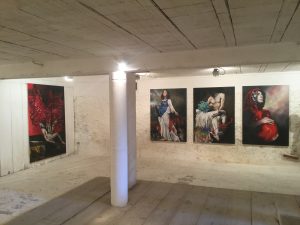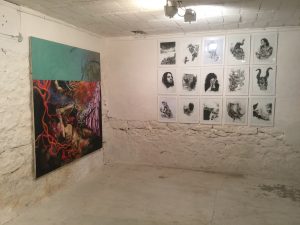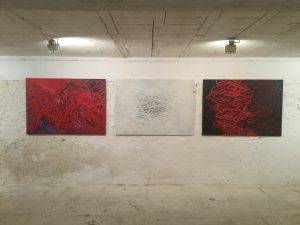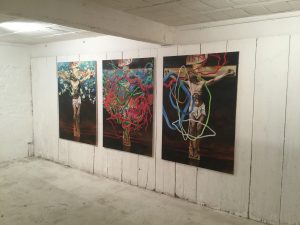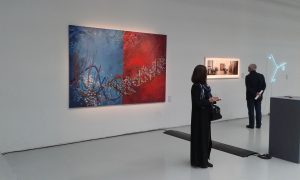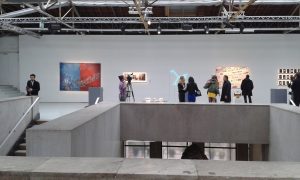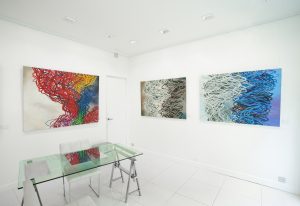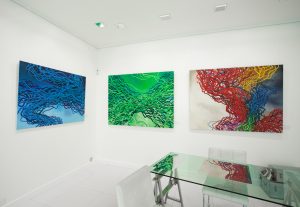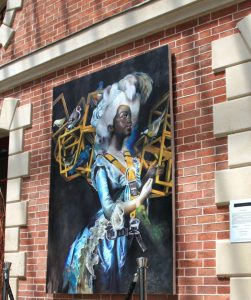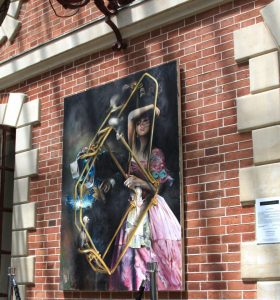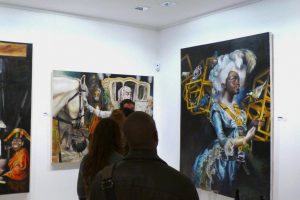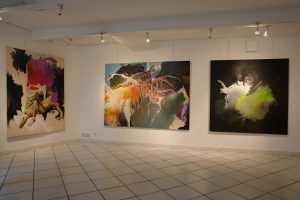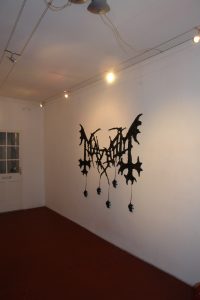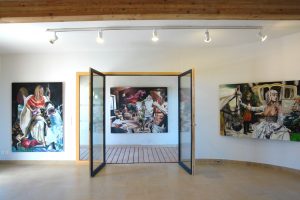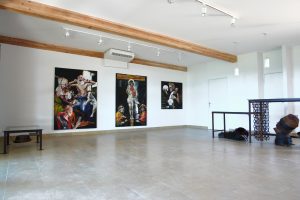JULIEN GRUDZINSKI
Born in La-Chaux-de-Fonds (Switzerland)
Works in Aix-en-Provence (France)
The evolution and the drastic transformations of our society lead today our glance towards a multitude of consumable visuals where all is worth. The passage from analog to digital produces new means of communication that have considerably changed our relationship to the image. In this context, I define cultural memory as a data bank of the past, isolated within a magma in constant mutation. Memories are catalogued, frozen under the varnish layer of history.
I try to materialize Western artistic heritages and then interweave them with the new changes of our century. The symbols that have shaped Western art are lost in an era of omnipresent information.
I recover snippets of old paintings. I use them as predominant graphic elements in my paintings. But the memory disintegrates. Time and the flood of new data encourage gaps. It is in this climate of uncertainty that my brush attempts to form quasi-organic structures, constituting a colored mesh.
In a way, my work is rooted in a dialogue between abstraction and representation. It is a synthesis of opposites, a combination of the rational and the irrational. Nothing is truly figurative. Nothing is truly abstract. I copy, I deconstruct, I deform, I erase, then I remodel and superimpose figurative elements from Western art, in order to question the materiality of painting while moving away from the constraints of representation, narration, but also abstraction.
I practice a cut-out painting, a figurative painting which becomes, by the intrusion or on the contrary the erasure of certain elements, polymorphic. Appears then as a second moment of the motif represented through the drapes and the flesh: a colored rhythm made of lines and spots. The forms are suspended and no longer manage to be fixed in legible compositions nor in recognizable structures. They do not build determinable spaces. But they swarm with gestures, lines, biomorphic figures, spots, colors. They sometimes seem to slip on the canvas, and end up masking the identity of the represented figures.
If I frequently proceed to preparatory collages on computer, the digital document holds a significant place in my process. It is not a simple source of inspiration. Its intrinsic nature resonates with my reflection and feeds my imagination. Because the image from the Internet has a particular presence, it gives to see by abstraction, it is decontextualized, isolated in time and space, it no longer belongs to history and is drowned in a mass of data where each image is worth another.
I use repentance, I voluntarily trim the different layers in order to maintain this layer status specific to computer graphics. These pieces of images are like stickers that I place on the canvas. The idea of superimposing a figurative element on another is to distort the original meaning of the initial painting which becomes a background. I eliminate the considerations linked to the staging to return to a purely pictorial problematic. In many of the paintings, the line is deliberately hesitant, sometimes the antithesis of the smooth and vigorous silhouettes associated with classical painting: trembling, the forms overflow and drool. What binds the works together is the constant tension that fuses figurative elements with abstract escapes.
Raised lines, split into two shades, light and dark, that I call « energy flows » recur. They are superimposed on each other, creating a cluster that seems chaotic without intertwining. They can be thin or thick, spaced or narrowed, creating different rhythms. The starting point for this series is a fascination with the human and financial flows of our time, which can have positive effects of mixing and hybridization, but which can also generate conflicts and collisions. I transpose them in explosive trajectories, bursts and superimpositions, so many forms and lines that draw the eye to a dizzying bottom. Here also, the border between representation and abstraction is blurred and moving. I use abstraction to counter the media inflation of the image and use the latter to undermine the metaphysical pretensions of abstraction. The line, simply painted, evokes a primitive, out- of-date line. But it can also resemble an artery, like a light or sound wave. None of these paintings has a beginning or an end: the beginning of one can be thought of as the continuation of the other, while its completion is actually the starting point of the next, giving rise to a sprawling proliferation of organic growths. The pictorial process resembles a weaving work, creating a kind of plexus, a real organic network made up of nerves and vessels. An impenetrable world.
Recently, I am interested in landscape painting through an abstract elaboration. Using scanned captures, I create a work base transcribed in three dimensions that I then crush. Composed randomly during my travels, the image appears as if gnawed, cut out. The imaginary territories become a carpet of colors. The direct reference to technology fades away in favor of a multicolored weaving. In a universe where man models the architecture of the habitat to excess, I project a malleable nature. I recompose in my own way idyllic and fantasized cartographies. These paintings attempt to dissipate the materiality of figurative painting in favor of an abstract illusionism. Up close, the touch is impressionistic. With hindsight, the pictorial treatments disappear to make room for an organic composition.
In the end, my work is similar to an attempt to free painting, as much from the codes of figurative painting as from those of abstract painting. What I seek, through my paintings, is the autonomy of painting.
L’évolution et les transformations drastiques de notre société conduisent aujourd’hui notre regard vers une multitude de visuels consommables où tout se vaut. Le passage de l’analogique au numérique produit de nouveaux moyens de communication qui ont considérablement bouleversé notre rapport à l’image. Dans ce contexte, je définis la mémoire culturelle comme une banque de données du passé, isolée au sein d’un magma en constante mutation. Les souvenirs sont répertoriés, figés sous la couche de vernis de l’histoire.
J’essaye de matérialiser les héritages artistiques occidentaux puis de les entremêler au rythme des nouveaux changements de notre siècle. Les symboles qui ont façonné l’art occidental se perdent au sein d’une époque où l’information est omniprésente.
Je récupère des bribes de tableaux anciens. Je les utilise comme éléments graphiques prédominants de mes toiles. Mais la mémoire se désagrège. Le temps et le déferlement de nouvelles données favorisent les lacunes. C’est dans ce climat d’incertitudes que mon pinceau tente de former des structures quasi organiques, constituant un maillage coloré.
D’une certaine manière, mon travail s’enracine dans un dialogue entre abstraction et représentation. S‘opère ainsi une synthèse des contraires, une combinaison de la raison et de l’irrationnel. Rien n’est véritablement figuratif. Rien n’est véritablement abstrait. Je copie, je déconstruis, je déforme, j’efface, puis je remodèle et superpose des éléments figuratifs issus de l’art occidental, afin d’interroger la matérialité de la peinture tout en m’éloignant des contraintes de la représentation, de la narration, mais également de l’abstraction.
Je pratique une peinture découpée, une peinture figurative qui devient, par l’intrusion ou au contraire l’effacement de certains éléments, polymorphique. Apparaît alors comme un second moment du motif figuré au travers des drapés et des chairs : un rythme coloré fait de lignes et de taches. Les formes sont suspendues et ne parviennent plus à se fixer en compositions lisibles ni en structures reconnaissables. Elles ne construisent pas d’espaces déterminables. Mais elles fourmillent de gestes, de lignes, de figures biomorphiques, de taches, de couleurs. Elles semblent parfois déraper sur la toile, et finissent par masquer l’identité des figures représentées.
Si je procède fréquemment à des collages préparatoires sur ordinateur, le document numérique tient une place significative dans mon processus. Il n’est pas une simple source d’inspiration. Sa nature intrinsèque entre en résonance avec ma réflexion et nourrit mon imaginaire. Car l’image issue d’Internet a une présence particulière, elle donne à voir par abstraction, elle est décontextualisée, isolée dans le temps et dans l’espace, elle n’appartient plus à l’histoire et se retrouve noyée dans une masse de données où chaque image en vaut une autre.
J’utilise le repentir, je rogne volontairement les différentes couches afin de maintenir ce statut de calque propre à l’infographie. Ces morceaux d’images sont comme des autocollants que je dispose sur la toile. L’idée de superposer un élément figuratif sur un autre revient à dénaturer le sens premier de la peinture initiale qui devient fond.
J’élimine les considérations liées à la mise en scène pour revenir à une problématique uniquement picturale. Sur de nombreux tableaux, la ligne est délibérément hésitante, parfois à l’antithèse des silhouettes lisses et vigoureuses associées à la peinture classique : tremblantes, les formes débordent et bavent. Ce qui lie les œuvres les unes aux autres, c’est la tension constante qui fait fusionner les éléments figuratifs aux évasions abstraites.
Des lignes en relief, dédoublées en deux teintes, claires et foncées que j’appelle « flux d’énergie » se manifestent de manière récurrente. Elles se superposent les unes sur les autres, créant un amas qui semble chaotique sans pourtant s’entremêler. Elles peuvent être fines ou épaisses, espacées ou resserrées, créant différents rythmes. Le point de départ de cette série est une fascination pour les flux humains et financiers de notre époque qui peuvent avoir pour effets positifs le métissage et l’hybridation, mais qui peuvent aussi engendrer des conflits et des collisions. Je les transpose dans des trajectoires explosives, des éclatements et des superpositions, autant de formes et de lignes qui entraînent le regard vers un fond vertigineux. Ici aussi, la frontière entre représentation et abstraction est floue et mouvante. Je me sers de l’abstraction pour contrer l’inflation médiatique de l’image et utilise cette dernière pour miner les prétentions métaphysiques de l’abstraction. La ligne, simplement peinte, évoque un tracé primitif, hors d’âge. Mais elle peut aussi s’apparenter à une artère, comme à une onde lumineuse, ou sonore. Aucune de ces peintures n’a de commencement ni de fin : le commencement de l’une peut être pensé comme la suite de l’autre, tandis que son achèvement est en réalité le point de départ de la suivante, donnant lieu à une prolifération tentaculaire d’excroissances organiques. Le processus pictural s’apparente à un travail de tissage, créant une sorte de plexus, véritable réseau organique constitué de nerfs et de vaisseaux. Un monde impénétrable.
Depuis peu, je m’intéresse à la peinture de paysage à travers une élaboration abstraite. En utilisant des captures scannées, je réalise une base de travail transcrite en trois dimensions que j’écrase ensuite. Composée au hasard de mes déplacements, l’image apparaît comme rongée, découpée. Les territoires imaginaires deviennent tapis de couleurs. La référence directe à la technologie s’estompe au profit d’un tissage multicolore. Dans un univers où l’homme modélise à outrance l’architecture de l’habitat, je projette une nature malléable. Je recompose à ma manière des cartographies idylliques et fantasmées. Ces toiles tentent de dissiper la matérialité de la peinture figurative au profit d’un illusionnisme abstrait. De près, la touche est impressionniste. Avec du recul, les traitements picturaux disparaissent pour laisser place à une composition organique.
Au final, mon travail s’apparente à une tentative d’affranchissement de la peinture, aussi bien vis à vis des codes de la peinture figurative que de ceux de la peinture abstraite. Ce que je recherche, à travers mes toiles, c’est l’autonomie de la peinture.
Selective Exhibitions
Individual Exhibitions
– Exhibition of paintings – Domaine des Jardinettes – Villelaure (84) May 2018
– Energy Flow season 2 – exhibition at Wide Painting gallery – Paris (5ème) june/august 2017
– Energy Flow – exhibition at Wide Painting gallery – Paris (5ème) May/July 2016
– In Symbols We Trust 2 – exhibition at Wide Painting gallery – Paris (5ème) April/July 2013
– Ordo Ad Chao – exhibition at the Susini gallery – Aix en Provence (13) September 2013
– In Symbols We Trust » hors les murs » – Jardins de Bagatelle – Paris (13ème) May/August 2012
– In Symbols We Trust – exhibition at the Wide Painting gallery – Paris (5th) April/August 2012
– Exhibition of drawings at the Frémiot gallery – Nice (06) March/April 2008
– Exhibition at the Ucellino gallery – Marseille (13) october 2007
– Exhibition at Vision future gallery – Nice (06) March/May 2007
– Exhibition at the Ucellino gallery – Marseille (13) May 2006
– Exhibition at Crous-Beaux-Arts gallery – Paris (6ème) January 2006
– Goat Dog – exhibition at the Sainte Réparate gallery – Nice (06) January/March 2006
– Exhibition at the Susini gallery – Aix en Provence (13) September 2004
Collective exhibitions
– Exhibition (with Annika Van Vugt) – Stiftung Sparkasse – Frankfurt (All) February 2015
– Heritage Days – painting exhibition – Gargas (84) September 2014
– The 20 years of the gallery Susini – Aix en Provence (13) March 2013
– <<II>> – exhibition at the RDF gallery – Nice (06) January/March 2009
– Exhibition at the Norbert Pastor gallery – Nice (06) October 2008
– «On va pas se plaindre » – exhibition at the Frémiot gallery – Nice (06) September 2007
– Night of the galleries – Vision Future gallery – Nice (06) june 2006
– Exhibition at the Vision Future gallery – Nice (06) March 2006
– Exhibition at the Espace Sextius – Aix en Provence (13) January 2006
Exhibitions/Fairs
– «Art and Care» – Palais de Tokyo – Paris (16ème) April 2015
– Affordable Art Fair » – Artemisia Gallery – London (GB) March 2007
– Mulhouse 006 – Contemporary Art Fair – Mulhouse (68) June 2006
Residences
– Stiftung Kunstdepot – Göschenen (Switzerland) August/September 2018
– Bridge Art Space – Frankfurt am Main (Germany) January 2015
– Susini gallery – Aix en Provence (13) july/august 2013
Selective Press
– Wall Street International Magazine (web US) May 2017
– Artsy (web) -Artist of the week May 2017
– Art Actuel (web) – article and illustrations May 2014
– Paris Capitale (paper) – article and illustrations July 2013
– Paris Capitale (paper) – article and illustrations June 2013
– Art Actuel (web) – article and illustrations May 2013
– Artsper (web) – article and illustrations May 2013
– Art Press n°396 (paper) – Black Metal and Plastic Arts (article and illustration) January 2013
– Galerie Susini n°04 (paper) – article and illustrations (residencies and exhibition) September 2013
– Xmas Time (web) – article and illustrations December 2012
– Revue & Corrigée n°89 (paper) – Connivence of extremes (article/illustration) September 2011
– Mulhouse 006 (paper) – article and illustration June 2006
– Nice Matin (paper) – article and illustration (the strange bestiary of J.Grudzinski) March 26, 2006
– Carriera della Costa Azzurra (paper) – article and illustration march 2006
– La Provence (paper) – article and illustration – exhibition at Susini gallery (Aix) june 2004
